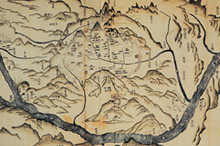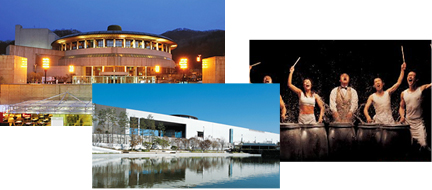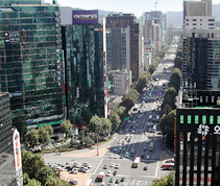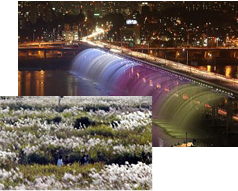Seoul, the capital of Korea
Seoul, the capital of Korea, combines a reverence for the past with a distinctive presence in the moment and an eye on the future. This cosmopolitan city, boasting world class design and cutting edge IT, offers tours of palaces from the Choseon dynasty alongside markets that specialize in high fashion and mass consumption, guest houses and five star hotels. Where else can you have lunch in a trendy international restaurant go for a hike -- on one of the many mountains in and around Seoul, then stop for a traditional Korean snack?

| Official Name | Seoul Teukbyeol-si |
| Location | Central west on the Korean Peninsula |
| Geography | The Han River flows through Seoul from east to west and mountains surround the city. Bukhan-san (Northern mountain) and Dobong mountain are to the north of Seoul, Geomdan mountain to the east, and Gwanak mountain and Cheongye mountain to the south. |
| Population | 10,488,327 (as of September 2009) |
| Surface Area | 605.33 sq.km |
| Governing Area | 25 Jachigu 497 dong (as of December 31st of 2009) |
| Language | Korea (Japanese, English and Chinese available in main tourist areas) |
| Religion | Christianity 25%, Buddhism 25%, and other various religions |
| Climate | Seoul has four very distinct seasons, with spring and fall being quite mild, summer hot and humid and winter being cold and dry. Although in August, considered to be the heart of summer in Seoul, the temperature reaches above 30℃, the average year round temperature remains around 11℃. Average annual rainfall is around 1,370mm, with seventy percent of that falling between June and September. |
In traditional Korean, the word ‘Seoul’ actually means ‘capital’.The Baekjae
Dynasty first established Seoul as the capital city of the Korean people in the
year 18 BC. Seoul remained the capital for the following 476 years, during which
the city--and Korean culture--thrived. Much of Korean culture evident today evolved
during that period. Centuries later, even after the capital was moved to present-day
Gongju during the Baekjae Dynasty, Seoul retained its prominence. Underscoring
Seoul's importance, competing dynasties fought for control over the area of Seoul
bordering the Han River. With the founding of the Choseon Dynasty in 1394, Seoul's
future was assured. In 1394, Seoul once again became the capital and flourished as a cultural and economic center for centuries.
Although Seoul was called "Hanyang" during the Choseon dynasty and "Gyeongseongbu" during the years of Japanese imperialism, the city officially became "Seoul" again after Korea regained its independence on August 15th,1945. In 1946, Seoul became a "do," a reference to a specific type of region, and was named the capital by the new Korean government.

Seoul is a city characterized by variety and
cultural vibrancy. The city is home to
extensive collections in over 700 museums,
including the National Museum and the National
Folk Museum, and numerous performance
centers, such as the Sejong Center for the
Performing Arts and the National Theater.
In addition, the city has more than
400 galleries exhibiting everything from the
most contemporary modern art to traditional
Korean furniture and African artifacts.
Alternatively, enjoy traditional festive dances, eat like the Choseon emperors, or visit a Bukcheon traditional house (a Hanok) in the town of the Choseon dynasty. For a taste of the contemporary, experience a wide
range of modern and fusion culture, then go to world-class performances like 'NANTA', 'JUMP' and 'B-boy'. Not tired yet? You can also see performances at Daehakro, Seoul Playground and Citizen's park, all outdoor cultural spaces in Seoul.

The 'Hi-Seoul Festival,' a favorite with tourists and locals, is held every May and features performances and activities for all ages.
Seoul is also making its mark in the business arena. It has been listed among
the top ten cities in the world for doing business and is working hard to cement its
position as a business center. Geographically, Seoul is strategically located in the
center of the Northeast Asian economy and offers a city with a pool of one of the
world's best-educated workforces. Among its growth industries: conventions,
tourism, digital content, fashion, design, R&D, finance, and retail distribution.
Seoul City is currently planning to designate an international financial zone in
which local and foreign financial companies will be given extensive support, both
through infrastructure development and various tax exemptions and reductions.
Also now under development are plans to turn the the Dongdaemun Design Plaza
& Park in the Dongdaemun area into a world-class design and fashion district.

Seoul boasts impressive natural resources - stunning mountains that surround
and define the city, and the beautiful Han River, running right through its center.
In addition, Seoul City is focused on bringing out its natural resources with an
emphasis on a greener downtown. The efforts include an extensive clean-up
and renovation of the area around the Han River as well as of Namsan
Mountain, in the heart of Seoul, to restore their natural beauty and turn them
into more eco-friendly areas. Seoul City will also gradually replace all carbon
fuel-powered public buses with natural gas-powered ones, a project scheduled
to be completed by the end of 2010. Having made remarkable progress in
reducing air pollution, Seoul City is already known as one of the cleanest
cities in Asia.

Buses that run on natural gas, a safe and affordable subway that connects you to every corner of the city, and bike trails along the Han River will enrich your life in Seoul.






































